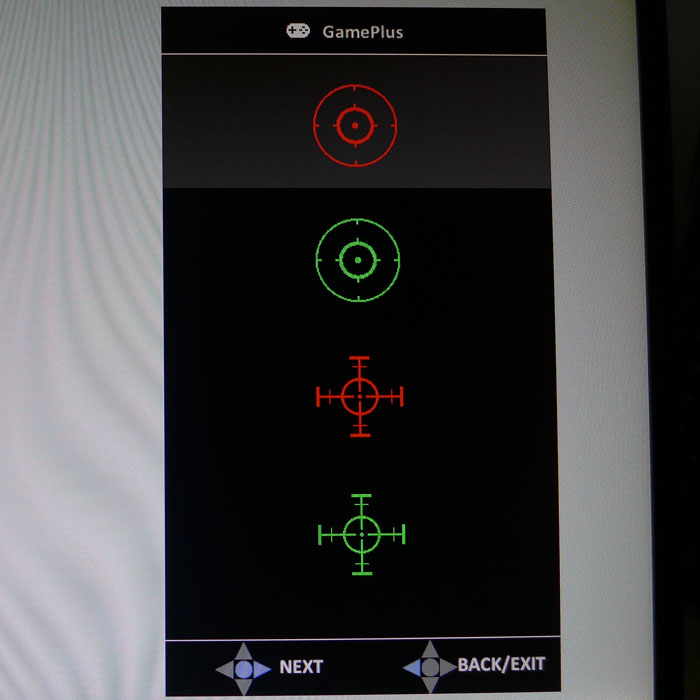Asus ROG Swift PG258Q Monitor Review
Why you can trust Tom's Hardware
OSD & Calibration
Pressing the joystick button brings up a comprehensive OSD. It’s efficiently laid out and offers everything a gamer could possible want in a high performance display.
Blue light filters are pretty much standard on all computer monitors these days. The PG258Q offers four levels plus off. Each dials in more warmth and makes white tones easier on the eyes.
Image controls are all in the Color menu where you’ll find the usual brightness and contrast sliders, plus three gamma presets, and four color temp options. The last one, User, has a single-point adjustment courtesy of RGB sliders that start at their maximums.
The Image menu has a few additional enhancements, like Dark Boost, which serves to improve shadow detail, and Adaptive Contrast, which increases dynamic range at the expense of detail. The darkest and lightest areas of the picture will be crushed in that mode. OD has two levels: Extreme and Normal, plus Off. The Extreme setting only earns that adjective in its level of ghosting. Moving object trails are quite pronounced. We strongly suggest sticking with Normal. Motion blur isn’t a factor at high refresh rates anyway.
You've also got the ULMB sub-menu. To enable it, turn off G-Sync and set the refresh to 144Hz or below. This is the first monitor we’ve seen that offers blur reduction above 120Hz. You can adjust the pulse width slider to dial in more reduction, but output suffers as a result. Even at the max setting (highest output), you’ll lose about 35% brightness, but fear not. Brightness is independently adjustable in both ULMB and G-Sync modes, and the PG258Q has plenty of output to compensate for the reduction.
Next up is the input selector. Not a big deal except that there is no hotkey for changing signal sources. You’ll have to go into the OSD every time. It’s hard to imagine too many users hooking this monitor up via HDMI though.
The final sub-menu is System Setup. There you’ll find language choices (21), menu position and timeout, keylock, signal info, Light In Motion, and the all-important factory reset. Speaking of signal info, every menu screen has resolution, refresh, and mode stats in the upper-right corner. Plus, the power LED changes color according to mode; red is G-Sync, green is ULMB, and white is Normal.
Get Tom's Hardware's best news and in-depth reviews, straight to your inbox.
If you’re looking for the picture modes, they’re only available in the GameVisual menu which is summoned with one of the control keys. There are six presets for various game types plus an sRGB setting that locks brightness at 210cd/m2 and grays out all other image adjustments.
GamePlus
You’ll find GamePlus in different forms on every ROG Swift display. The PG258Q has crosshair, timer, FPS counter, and display alignment features.





The reticles come in green or red, and in two different styles. Once activated, you can move it around the screen with the joystick.
The countdown timer can also be placed anywhere and starts at 30, 40, 50, 60, or 90 minutes. You won’t miss its large white digits surrounded by a gray box.
The FPS counter is similarly large and yellow, regardless of the background color. It is stationary and cannot be moved from its position in the upper right.
Display Alignment is an easy way to line up multiple ROG Swifts. Just line up the red arrows and you’re good to go!
As in previous ROG Swift monitors, the GamePlus features can only be used one at a time.
Calibration
The PG258Q’s best starting mode is Racing, which is also the default. It needs some help in all departments, however. Gamma is quite a bit off the 2.2 standard, while grayscale runs fairly red. Additionally, color saturation is quite high, which looks great at first until you realize a lot of fine details are being crushed. To remedy this, we adjusted the RGB sliders, turned down the contrast, and set Dark Boost to Level 1. This brings everything nicely in line, and our final test results show a decent level of accuracy with no real loss of contrast. We recommend using our settings if you don’t have the means to calibrate your PG258Q.
| Asus PG258Q Calibration Settings | |
|---|---|
| GameVisual | Racing |
| Brightness 200 cd/m2 | 37 |
| Brightness 120 cd/m2 | 10 |
| Contrast | 41 |
| Gamma | 2.2 |
| Color Temp User | Red 95, Green 100, Blue 100 |
| Dark Boost | 1 |
MORE: Best Computer Monitors
MORE: How To Choose A Monitor
MORE: All Monitor Content

Christian Eberle is a Contributing Editor for Tom's Hardware US. He's a veteran reviewer of A/V equipment, specializing in monitors. Christian began his obsession with tech when he built his first PC in 1991, a 286 running DOS 3.0 at a blazing 12MHz. In 2006, he undertook training from the Imaging Science Foundation in video calibration and testing and thus started a passion for precise imaging that persists to this day. He is also a professional musician with a degree from the New England Conservatory as a classical bassoonist which he used to good effect as a performer with the West Point Army Band from 1987 to 2013. He enjoys watching movies and listening to high-end audio in his custom-built home theater and can be seen riding trails near his home on a race-ready ICE VTX recumbent trike. Christian enjoys the endless summer in Florida where he lives with his wife and Chihuahua and plays with orchestras around the state.